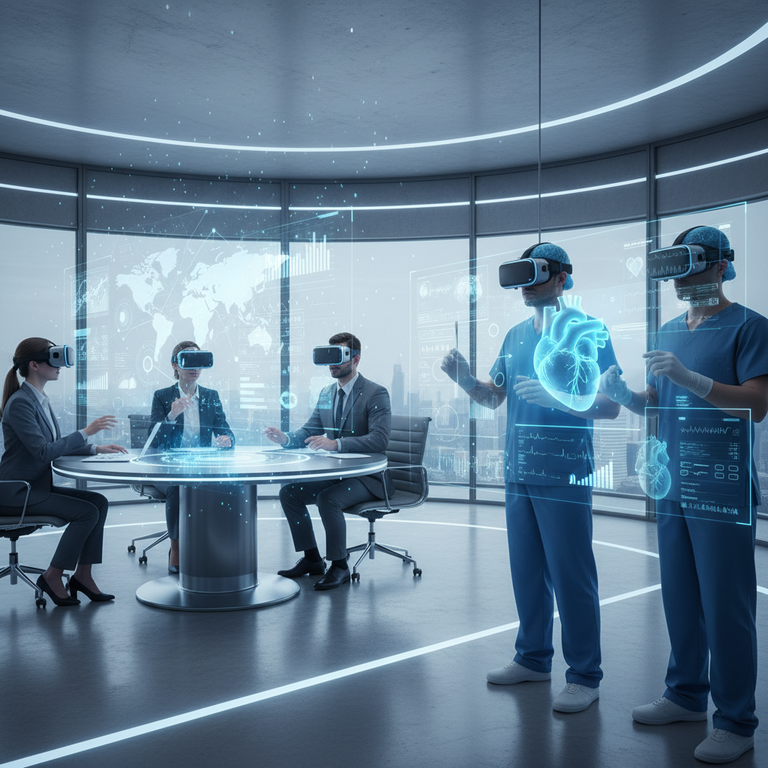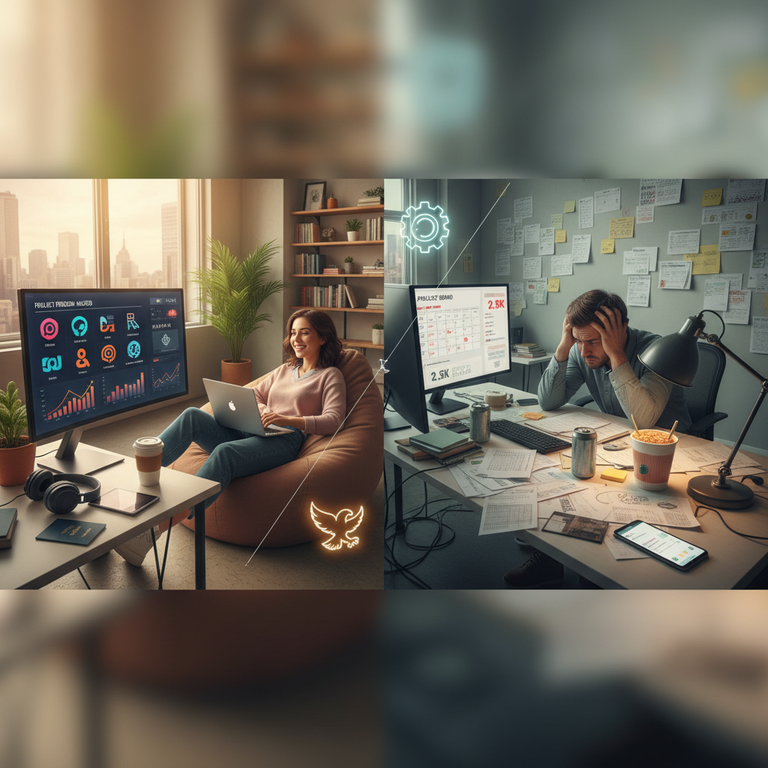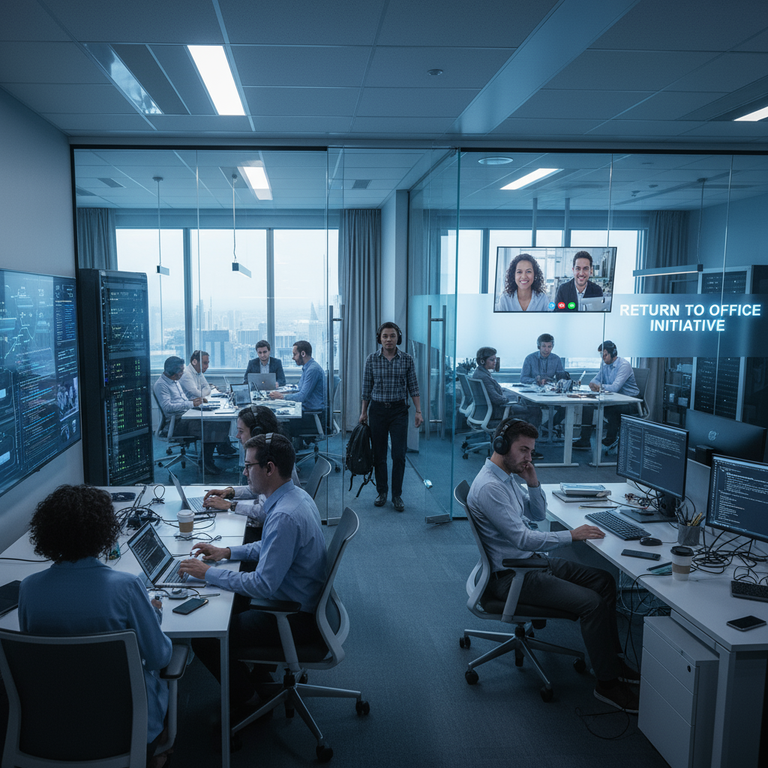The Metaverse and Work: How Virtual Reality Will Change Meetings and Training (A Realistic Analysis)
Few concepts in recent memory have experienced such a whiplash-inducing cycle of hype and disillusionment as “The Metaverse.” Just a few years ago, it was hailed as the inevitable successor to the internet, a multi-trillion dollar opportunity that would see us all living, shopping, and working in fully immersive digital worlds. Today, following a market correction and a shift in tech narratives, the word “Metaverse” often elicits skepticism or even ridicule.
This “hype crash,” however, obscures a critical truth: while the *social* vision of the Metaverse has stalled, the *professional* applications are quietly growing stronger. The underlying technologies—specifically Virtual Reality (VR) and Augmented Reality (AR)—are proving to be powerful, high-value tools. We are simply finding that their true potential isn’t in replacing the office happy hour, but in revolutionizing high-stakes professional **meetings and training**.
This is not a futurist fantasy. This is a realistic analysis of The Metaverse and Work. We will cut through the noise to show you where this technology is *already* providing massive ROI and how it will realistically change professional environments in the coming years.
What ‘The Metaverse and Work’ Actually Means (It’s Not a Game)
First, we must reset the definition. The professional Metaverse is not about buying digital real estate or attending a virtual concert with your colleagues. In a business context, The Metaverse and Work simply means “persistent, immersive 3D digital environments for professional use.”
Think of it not as a “place,” but as a new *medium*. Just as the internet gave us “webpages” and the smartphone gave us “apps,” Virtual Reality and AR are giving us “spatial environments.” The core value proposition is “presence”—the feeling of *being there* with people or interacting with data in a way that a flat 2D screen (like Zoom) can never replicate. This sense of presence has two killer applications: training and collaboration.
The Future of Training: From Passive Watching to Active Doing
This is the most powerful, undeniable, and currently valuable application of The Metaverse and Work. For a century, professional training has been a low-retention, 2D process: reading manuals, watching videos, or sitting in a classroom. Virtual Reality shatters this model by moving from “learning” to “doing.”
It is the ultimate “flight simulator” for every industry. It allows for perfect practice in a zero-risk, zero-cost environment. The knowledge retention from this “embodied learning” is exponentially higher than passive observation.
1. High-Stakes and Physical Skills
This is the “no-brainer” ROI. Industries where mistakes are expensive or dangerous are leading this charge.
- Medicine: Surgeons use VR to practice a complex, new surgical procedure hundreds of times on a hyper-realistic digital patient before ever touching a real one.
- Manufacturing & Engineering: A new factory worker can be trained to operate a $10 million piece of heavy machinery in a VR simulation, eliminating the risk of injury or breaking the equipment.
- Aviation & Defense: This is the origin of the technology. Pilots and soldiers have used high-fidelity simulations for decades. Virtual Reality is simply making this level of **training** accessible to everyone.
2. Onboarding and Process Training
Companies like Walmart and Bank of America have deployed tens of thousands of VR headsets to train employees at scale. A new retail employee can be put through a VR simulation of a “Black Friday” rush. A new bank teller can be trained to handle a difficult customer or a complex transaction. This “muscle memory” **training** is impossible to replicate in a group seminar.
3. Soft Skills Training
This is the cutting-edge. Platforms now use AI-powered avatars to simulate a “difficult conversation” with an employee, a high-stakes sales negotiation, or a public speaking engagement. This allows professionals to practice their leadership, empathy, and communication skills in a private, repeatable environment, receiving AI-driven feedback on their performance. This is a level of **training** that Virtual Reality is uniquely positioned to solve.
The Future of Meetings: Beyond ‘Zoom Fatigue’
The second pillar of The Metaverse and Work is collaboration. After years of “Zoom Fatigue,” we all know the limits of 2D video calls. They are flat, “disembodied,” and cognitively draining. It’s difficult to brainstorm, read a room, or feel a human connection.
Virtual Reality meetings are not a replacement for *all* meetings, and this is where our realistic analysis is key. They are a *bad* replacement for a 15-minute daily check-in. They are a *phenomenal* replacement for high-value, creative, and collaborative sessions that are impossible to do on a flat screen.
The “Killer App”: 3D Data and Design Visualization
This is where VR meetings shine. The value is not in sitting around a virtual table. The value is in *getting up* and collaborating *inside* the project itself.
- Engineering & Design: A team of automotive engineers, scattered across three continents, can “walk around” and “inside” a full-scale 3D model of a new engine. They can grab parts, test clearances, and make design changes in real-time.
- Architecture & Construction: An architect can walk a client through their new home *before* a single brick is laid, allowing for immediate feedback on the “feel” and scale of a space.
- Data Science: Instead of looking at a 2D spreadsheet, a team of data scientists can be “immersed” in a 3D visualization of their data, allowing them to spot trends and outliers that would be invisible on a flat chart.
A Realistic Analysis: The Hurdles We Must (And Will) Overcome
This brings us to the “reality check” portion of our realistic analysis. This future is not arriving tomorrow. The mainstream adoption of The Metaverse and Work is still held back by significant, tangible hurdles.
1. The Hardware Hurdle
This is the single biggest barrier. Virtual Reality headsets are still too heavy, too expensive, and too socially awkward for mass-market, “all-day” use. The battery life is limited, and the “motion sickness” issue is real for many. Until the hardware becomes as light, comfortable, and affordable as a pair of glasses (like Apple’s Vision Pro aims to be, but at a high price), it will remain a “session-based” tool, not a “permanent” one.
2. The Interoperability Hurdle
The “Metaverse” is not one thing. It’s a dozen different, walled-garden ecosystems. Meta’s *Horizon Worlds* (for Quest) doesn’t talk to Microsoft’s *Mesh* (for Teams), which doesn’t talk to Apple’s *visionOS*. This lack of a common “operating system” or protocol (like the “http” of the web) is fracturing the market and slowing down adoption. The Metaverse and Work can’t scale if every company has to bet on a single, proprietary platform.
3. The “Hybrid” Hurdle
The “hybrid” problem is very real. Having three people in VR meetings with avatars and three people in the physical conference room is a clunky, disjointed experience. The “avatar” representation still feels primitive and often breaks the social connection it’s trying to build. This “uncanny valley” needs to be solved before VR meetings can feel truly natural.
Conclusion: The Future of ‘The Metaverse and Work’ Is Niche and Vertical
So, what is the conclusion of our realistic analysis? The idea of a single, universal “Metaverse” where we all work in a giant virtual office is dead. That was a sci-fi fantasy, not a business plan.
The *real* future of The Metaverse and Work is “vertical” and “niche-specific.” It’s not one big thing; it’s a hundred small, revolutionary things. It is not a replacement for the internet; it’s a new, powerful computing interface that enables *spatial* computing.
Do not expect your entire company to be on VR headsets by 2026. *Do* expect Virtual Reality to become the undisputed, gold-standard for all high-stakes **training** in medicine, manufacturing, and defense. *Do* expect your engineering, design, and data teams to use VR/AR as their primary tool for complex, 3D collaborative meetings.
The Metaverse is not a *place* you will go. It is a *tool* you will use. And like all powerful tools, its adoption will be gradual, practical, and driven not by hype, but by a clear, undeniable, and profitable return on investment.







